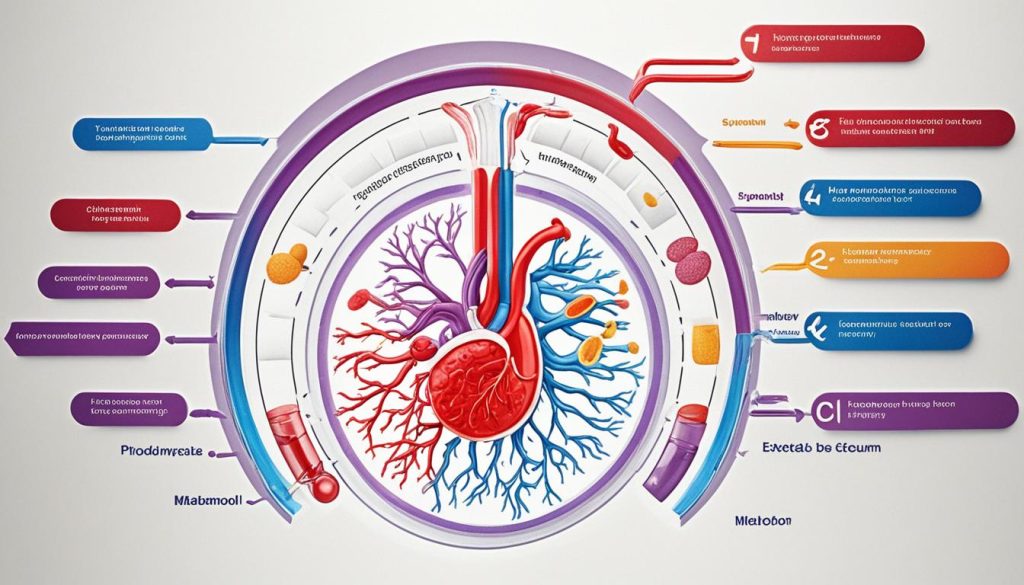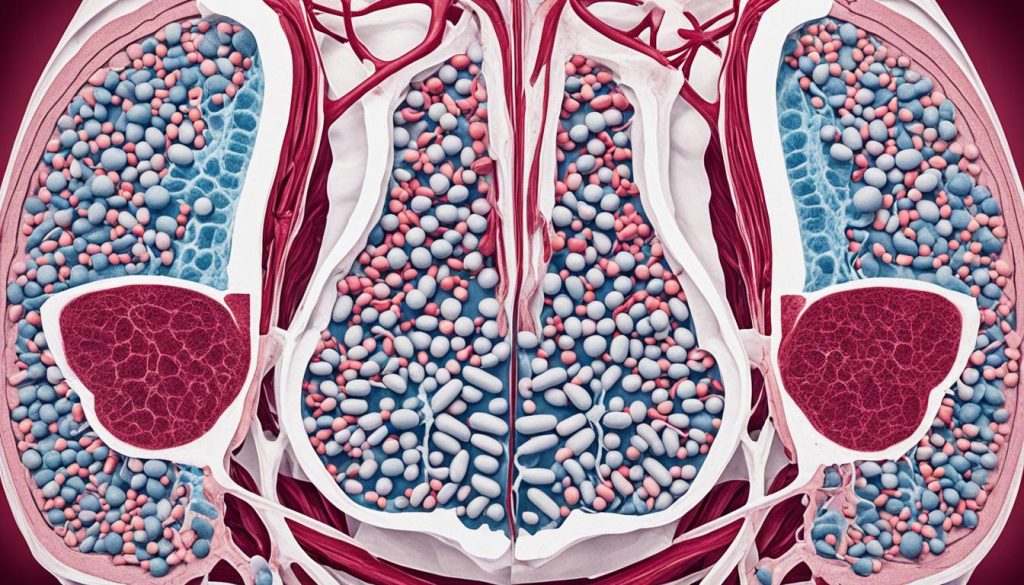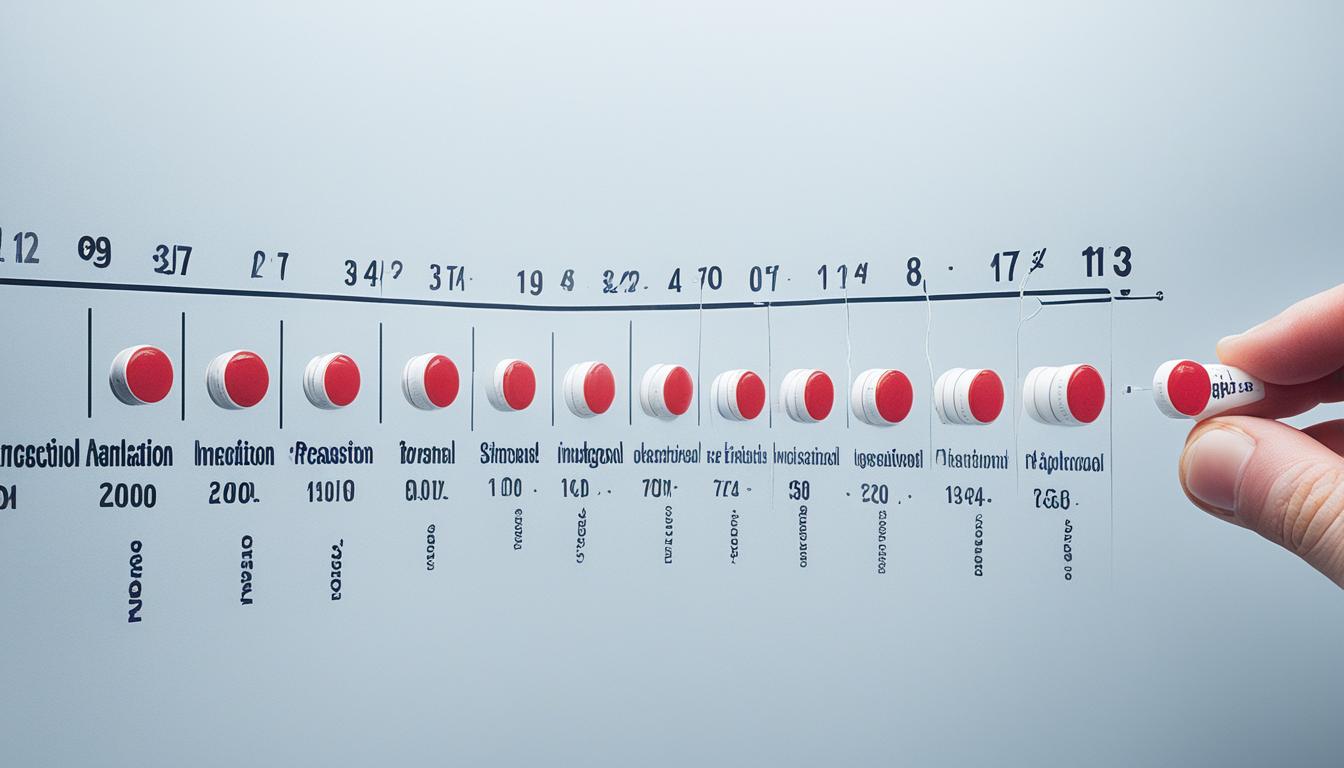When taking paracetamol, it’s important to remember that it doesn’t treat the underlying cause of pain but provides relief by easing the sensation of pain. The exact mechanism of how paracetamol works is not fully understood, but it is believed to block pain signals from reaching the brain, providing pain relief.
So, how long does it take for paracetamol to take effect? In most cases, paracetamol starts to work within 30 minutes to 1 hour after taking a dose. However, individual responses may vary. It’s important to follow the recommended dosage instructions and allow sufficient time for the medication to take effect.
Now that you know how long paracetamol takes to work, let’s explore how it actually works and other important considerations when taking this medication.
How Does Paracetamol Work?
Paracetamol is a widely used medication known for its ability to provide relief from pain and reduce fever. However, the exact mechanism of how paracetamol works is not fully understood. Nonetheless, it is believed to have analgesic (pain-relieving) and antipyretic (fever-reducing) properties.
Paracetamol works by blocking or reducing the production of certain chemicals in the body that are responsible for transmitting pain signals to the brain. By doing so, it helps alleviate pain and discomfort. However, it is important to note that paracetamol is not effective in treating inflammation, such as in conditions like arthritis.
It is crucial to remember that paracetamol provides temporary relief from pain and fever and does not address the underlying cause. Therefore, it is always advisable to consult a healthcare professional for a proper diagnosis and appropriate treatment if symptoms persist.
To summarize, the precise mechanism of action of paracetamol is still not fully understood, but it is believed to block pain signals and reduce the production of certain chemicals in the body responsible for transmitting pain and fever signals. Although paracetamol offers relief from pain and fever, it does not treat the underlying cause and should be used under the guidance of a healthcare professional.
How Long Does Paracetamol Take to Work?
When it comes to taking paracetamol, it’s important to follow the recommended dosage and timing guidelines to ensure safe and effective use.
For adults and children 12 years and older, the recommended dosage of paracetamol is no more than 1g every 4 to 6 hours, with a total daily maximum of 4g. This means that you should not exceed 1g per dose, and you should not take more than 4g in a 24-hour period.
For children aged 1 month to 12 years, the dosage is based on their weight. The general guideline is 15 mg of paracetamol per kg of body weight, given every 4 to 6 hours. However, it’s important to note that the maximum number of doses in a 24-hour period should not exceed 4.
It is crucial to follow the recommended dosage instructions and not exceed the maximum daily limit. Taking more than the recommended dosage can lead to liver damage or other serious side effects. Always consult with a healthcare professional for specific dosage instructions for children.
Paracetamol can be taken with or without food. However, it is recommended to take it with a meal or snack to help reduce the risk of stomach upset.
The timing of paracetamol doses is also important. Make sure to space out your doses at least 4 hours apart. This means that if you take a dose at 9 am, you should wait until at least 1 pm before taking another dose. This allows enough time for the previous dose to be absorbed and for the medication to take effect.

Remember, always read and follow the instructions on the packaging or consult with a healthcare professional for personalized dosage and timing recommendations.
Onset and Duration of Paracetamol Effectiveness
When it comes to paracetamol, understanding its onset of action and effectiveness duration is essential for managing pain and fever effectively.
Paracetamol typically starts to take effect within 30 minutes to 1 hour after ingestion, providing quick relief for those in need. However, the duration of its effectiveness may vary depending on several factors. On average, paracetamol’s effectiveness lasts for about 4 to 6 hours, offering a significant window of relief.
It’s important to note that individual responses to paracetamol can differ. Factors such as age, weight, severity of symptoms, and the form of paracetamol taken (e.g., tablets, capsules, liquids) can influence both the onset and duration of effectiveness. Some individuals may experience faster or longer-lasting effects, while others may have varying responses.
To effectively manage pain or fever with paracetamol, it’s recommended to follow the recommended dosage instructions and consult a healthcare professional if needed. Depending on the severity of symptoms, additional doses may be necessary within the recommended timeframe to maintain the desired level of relief.

With paracetamol’s quick onset and lasting effectiveness, it remains a popular choice for relieving pain and reducing fever. However, it’s important to use paracetamol responsibly and within the recommended guidelines to minimize the risk of adverse effects.
Absorption and Metabolism of Paracetamol
When it comes to the absorption and metabolism of paracetamol, the journey begins in the gastrointestinal tract. Paracetamol is rapidly absorbed from this region and quickly enters the bloodstream. Within 30 to 60 minutes after ingestion, the concentration of paracetamol in the blood reaches its peak, allowing it to start delivering its therapeutic effects.
Once in the bloodstream, paracetamol undergoes metabolism primarily in the liver. This vital organ plays a crucial role in breaking down paracetamol through various metabolic pathways. The majority of paracetamol is conjugated with sulfate or glucuronide, resulting in metabolites that are then excreted in the urine.
However, it’s important to note that a small portion of paracetamol is metabolized by the cytochrome P450 enzyme system in the liver. When excessive amounts of paracetamol are taken, this metabolic pathway can lead to the formation of a toxic metabolite that can cause liver damage. Therefore, it is essential to adhere to the recommended dosage to prevent the risk of adverse effects.
In terms of elimination, paracetamol has a relatively short half-life. On average, it takes approximately 2 to 4 hours for the body to eliminate paracetamol completely.
To summarize:
| Key Points |
|---|
| Paracetamol is rapidly absorbed from the gastrointestinal tract and reaches peak concentrations in the blood within 30 to 60 minutes. |
| Paracetamol is primarily metabolized in the liver through various pathways. |
| The majority of paracetamol is conjugated with sulfate or glucuronide and excreted in the urine. |
| A small portion of paracetamol is metabolized by the cytochrome P450 enzyme system, which can lead to the formation of a toxic metabolite if excessive amounts are taken. |
| The half-life of paracetamol elimination from the body is typically around 2 to 4 hours. |
Understanding the absorption and metabolism of paracetamol is crucial in optimizing its effectiveness and minimizing the risk of adverse reactions. It is always advisable to consult a healthcare professional for personalized guidance on the appropriate use of paracetamol.

Safety and Side Effects of Paracetamol
Paracetamol is a widely used medication for pain relief and fever reduction. When taken within the recommended dosage guidelines, paracetamol is generally considered safe for adults. However, it is crucial to be cautious and understand the potential side effects and maximum daily dose to avoid any adverse reactions.
One of the most serious side effects of paracetamol is liver damage. Exceeding the maximum daily dose or taking it for an extended period increases the risk of liver toxicity. It is essential to follow the recommended dosage and avoid exceeding the maximum dose of paracetamol per day for adults, which is 4 grams (or 4000 milligrams). Taking more than the recommended dose can overwhelm the liver’s capacity to metabolize the drug, leading to liver damage.
In addition to liver damage, paracetamol can also cause other common side effects, such as drowsiness, rashes, and itching. While these side effects are generally mild and temporary, it is essential to pay attention to any unusual symptoms and consult a healthcare professional if they persist or worsen.

It is worth noting that individuals may have different responses to paracetamol, and some may be more susceptible to side effects than others. It is important to discuss any concerns or medical conditions with a healthcare professional before taking paracetamol to ensure its safety and suitability for individual needs.
Paracetamol in Specific Situations – Children, Pregnancy, and Breastfeeding
Paracetamol is a commonly used medicine for both children and adults, providing effective relief from pain and reducing fever. When it comes to administering paracetamol to children, it is crucial to consider the child’s weight and age to determine the appropriate dosage. Paracetamol can be given to children, but it is important to follow the recommended guidelines and consult a healthcare professional for accurate dosing instructions.
For babies, the time it takes for paracetamol to work may vary. When using paracetamol for babies, it is advised to consult with a healthcare professional to ensure appropriate dosing based on the baby’s age and weight. It is essential to follow medical advice and give the correct dosage to achieve the desired effect.
Paracetamol Dosage for Children:
| Child’s Age | Paracetamol Dosage | Recommended Timing |
|---|---|---|
| 1 month to 3 months | 2.5ml | 4-6 hours |
| 4 months to 5 months | 2.5ml | 4-6 hours |
| 6 months to 12 months | 5ml | 4-6 hours |
| 1 year to 4 years | 5-10ml | 4-6 hours |
| 5 years to 10 years | 10-15ml | 4-6 hours |
| 11 years to 12 years | 15ml | 4-6 hours |
Paracetamol is generally safe to use during pregnancy, but it is crucial to take it at the lowest effective dose for the shortest possible time. Pregnant women should consult their healthcare providers before taking any medication, including paracetamol, to ensure it is suitable for their specific situation.
When it comes to breastfeeding, paracetamol is considered safe to use in recommended doses and is the preferred choice for pain relief. It is important to follow the recommended dosage guidelines and consult with a healthcare professional if there are any concerns.
Overall, paracetamol can be safely used in specific situations such as children, pregnancy, and breastfeeding. However, it is always advisable to consult with a healthcare professional for accurate dosing instructions and to ensure the best possible outcome.
Conclusion
Paracetamol, a widely used painkiller and fever reducer, offers effective relief for mild to moderate pain and fever. With a relatively quick onset of action, it typically takes effect within 30 minutes to 1 hour, providing relief for approximately 4 to 6 hours. Adhering to the recommended dosage is crucial to avoid the risk of liver damage or other serious side effects.
Paracetamol works by blocking pain signals to the brain, alleviating discomfort. However, it is important to note that it does not address the underlying cause of pain or fever. While it is generally safe to use, it is essential to seek guidance from a healthcare professional for appropriate dosing and comprehensive advice.
Paracetamol can be safely administered in specific situations such as children, during pregnancy, and while breastfeeding. However, it is always recommended to consult with a healthcare professional to determine the appropriate dosage for these scenarios. By following the guidance of healthcare professionals, individuals can benefit from the therapeutic window of paracetamol, ensuring optimal dosage response and effectively managing pain and fever.
FAQs
What is the recommended dosage and timing of paracetamol?
The recommended dosage of paracetamol for adults and children 12 years and older is no more than 1g every 4 to 6 hours, with a total daily maximum of 4g. The timing of doses should be spaced at least 4 hours apart.
How long does paracetamol last?
The duration of paracetamol’s effectiveness varies but usually lasts for about 4 to 6 hours.
How is paracetamol absorbed and metabolized in the body?
Paracetamol is rapidly absorbed from the gastrointestinal tract and reaches peak concentrations in the blood within 30 to 60 minutes after ingestion. It is metabolized primarily in the liver through various pathways.
What are the safety considerations and side effects of paracetamol?
Paracetamol is generally considered safe when taken within the recommended dosage guidelines. Common side effects include drowsiness, rashes, and itching. However, exceeding the maximum daily dose or taking it for an extended period can lead to liver damage and other serious side effects.
Can paracetamol be given to children, pregnant women, and breastfeeding mothers?
Paracetamol can be given to children based on their weight and age. It is recommended for reducing fever and relieving pain in children. Pregnant women can take paracetamol for pain relief, but it is advised to take it at the lowest effective dose for the shortest possible time. When breastfeeding, paracetamol is considered safe to use in recommended doses and is the preferred choice for pain relief.
Is paracetamol effective in treating specific conditions?
Paracetamol is effective in treating various conditions such as headaches, muscle aches, toothaches, period pain, and arthritis. However, it is important to note that paracetamol does not address the underlying cause of pain or fever but provides temporary relief.

